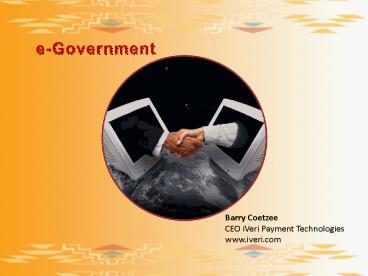eGovernment - PowerPoint PPT Presentation
1 / 29
Title:
eGovernment
Description:
There are pockets of eGovernment activity in Nigeria ... Source: Accenture's eGovernment Leadership: High Performance, Maximum Value Report 2004 ... – PowerPoint PPT presentation
Number of Views:86
Avg rating:3.0/5.0
Title: eGovernment
1
e-Government
Barry Coetzee CEO iVeri Payment
Technologies www.iveri.com
2
- e-Government
- From Wikipedia, the free encyclopedia
- e-Government (from electronic government, also
known as e-gov) refers to governments use of
information technology to exchange information
and services with citizens, businesses, and other
arms of government. - The primary delivery models are
- Government-to-Citizen or Government-to-Customer
(G2C), - Government-to-Business (G2B),
- Government-to-Government (G2G)
- Government-to-Employees (G2E).
- The most important anticipated benefits of
e-government include improved efficiency,
convenience, and better accessibility of public
services.
3
Todays modern government needs to go to
citizens/customers (Using the technology that
the customers has available) Mobile Phones (SMS,
USSD, IVR, WAP, Java) Internet (Browser,
eMail) Fixed Line (IVR)
Traditional governments expect citizens/customers
to come to them (Government provides and is in
control of these channels) Branches
4
e-Government could include Utilities
- Utility providers have a limited retail footprint
for interaction with their customers and
acceptance of payments. - They want electronic access to electronic money
holders as it gives them - A larger cost effective point of presence
- integration into their billing systems
- guaranteed payments, and
- reduces their cash costs and risks.
- Guaranteed payment
5
e-Government leaders are reaping tangible savings
Canada recently conducted a comparison of
channel costs per transaction that showed the
cost savings from online service are significant.
Its survey showed that An in-person
transaction costs the government Can44, a mail
transaction costs Can38 and a telephone (agent)
transaction costs Can8 In contrast, an online
transaction costs less than Can1 Source
Accentures eGovernment Leadership High
Performance, Maximum Value Report 2004
6
- Is e-Government about the Internet or Mobile?
- ... Or
- ... What is the best channel?
- Conventional telephone - call centers, automated
voice responses, FAX on demand of forms and
information - Personal Computers and the Internet - from simple
display of information to highly sophisticated
interactive services with payment - In an assisted mode through integrated service
delivery centers in convenient locations, rural
Internet kiosks and cyber cafes. - Mobile digital telephony and messaging technology
7
(No Transcript)
8
- e-Government
- From Wikipedia, the free encyclopedia
- e-Government (from electronic government, also
known as e-gov) refers to governments use of
information technology to exchange information
and services with citizens, businesses, and other
arms of government. - The primary delivery models are
- Government-to-Citizen or Government-to-Customer
(G2C), - Government-to-Business (G2B),
- Government-to-Government (G2G)
- Government-to-Employees (G2E).
- The most important anticipated benefits of
e-government include improved efficiency,
convenience, and better accessibility of public
services.
Transactions
Channels
9
(No Transcript)
10
(No Transcript)
11
- Data Rich Transactions
- Requires direct database interaction
- Protect citizen data
- Automated back-office
- Audit Trail
- Guaranteed Electronic Payments
- Guaranteed
- Irrefutable Cash-like
- Secure
- Electronic
- No manual processing
- Automatic reconciliation
- Reporting
- Universal Interface
- Controlled by Gov
- Universal User Experience
- Convenient
- Multi-channel
- Secure
- Use available payment channels
12
(No Transcript)
13
No single channel is perfect
14
No single channel is perfect
15
- Limited screen size
- No uniform screen technology
- Multiple technology capabilities
- SMS NO Security NO data richness ALL Phones
- USSD NO Security LIMITED Data ALL Phones
- WAP GOOD Security GOOD Data LIMITED Phones
- Voice IVR NO Security LIMITED Data ALL
Phones - Java GOOD Security GOOD Data LIMITED Phones
16
(No Transcript)
17
(No Transcript)
18
E Gov delivered in an assisted mode through
integrated service delivery centers in convenient
locations, rural Internet kiosks and cyber cafes.
19
(No Transcript)
20
- Citizen Convenience
- Government and Utility payments are generally
regular - Brings Point of Payment closer to citizen
- Bank and Internet costs to citizen are less than
transport and time costs currently experienced - Hours of business are longer
- Service levels are consistent
- Safer No Cash
21
- Government
- End to End Efficiency
- Consistent Service Levels
- Scalability
- Reach
- No Cash and related issues
22
- Internet Host
- Increased sustainable business
23
- Financial Services
- Demand for products that are more convenient
- Income from Fees
24
eGov is already happening
25
(No Transcript)
26
There are pockets of eGovernment activity in
Nigeria Most Government organisations are at
the PUBLISH phase With static websites,
providing basic information Few Government
organisations are at the TRANSACT phase FIRS
utilising the InterSwitch platform CAC
JAMB/WAEC Most Government organisations
by-pass the INTERACT phase Little or no
solicitation of feedback, no closure of the
loop The government is far from the INTEGRATE
phase There is no single point of interaction
with the Government Most government
organisations run separate un-integrated
programmes Most government organisations do not
have back office systems eProcurement is not
yet in practice Ongoing attempts to establish
back-office systems and integrate across selected
ministries (IFEMIS, HRMS etc.)
Source Accentures eGovernment Leadership High
Performance, Maximum Value Report 2004
27
(No Transcript)
28
(No Transcript)
29
e-Government
Barry Coetzee CEO iVeri Payment
Technologies www.iveri.com































